Don't wanna be here? Send us removal request.
Text
References
Barrett, E., and Bolt, B. (Eds.). (2014). Practice as research: Approaches to creative arts enquiry. Bloomsbury Publishing.
Carrington, Suzanne B. (2007) Young people as researchers using image-based research: a focus on methodology. In Proceedings AERA National Meeting, Chicago, USA.
Carrington, Suzanne B. (2007) Young people as researchers using image-based research: a focus on methodology. In Proceedings AERA National Meeting, Chicago, USA.
Kourkoulis, L. (2021). The Network of Influences That Shape the Drawing and Thinking of Fifth Grade Children in Three Different Cultures: New York, US, Molaos, Greece, and Wadie Adwumakase, Ghana. Teachers College, Columbia University. https://academiccommons.columbia.edu/doi/10.7916/d8-753v-t132/download
Ravenscroft, I. ed., 2009. Chapter 6: The Folk Theory of Colours and the Causes of Colour Experience. Minds, ethics, and conditionals: themes from the philosophy of Frank Jackson. Oxford University Press.
Rezaee, F., Hoseinikhah, A., Kian, M., & Kamran, A. (2022). A Comparative Study of Art Curriculum in Early Childhood Education of Australia, Canada, Finland, New Zealand and Iran. Iranian Journal of Comparative Education, 5(4), 2098-2125. https://journal.cesir.ir/article_160839.html
Sanders, A. M. C. (2009). Identity hokey pokey:" put your whole self in" with theatre as your guide (Doctoral dissertation, California State University, Sacramento). https://scholars.csus.edu/esploro/fulltext/graduate/IDENTITY-HOKEY-POKEY-PUT-YOUR-WHOLE/99257972358301671?repId=12255750810001671&mId=13255750780001671&institution=01CALS_USL
Issuu. (2023). “Creativity Takes Courage” - Henri Matisse. Available at: https://issuu.com/thebsbblog/docs/art_catalogue_23/s/25044502 (Accessed 26 August 2023).
Kourkoulis, L. (2021). The Network of Influences That Shape the Drawing and Thinking of Fifth Grade Children in Three Different Cultures: New York, US, Molaos, Greece, and Wadie Adwumakase, Ghana. Teachers College, Columbia University. https://academiccommons.columbia.edu/doi/10.7916/d8-753v-t132/download
Lomax, Y. (1981). Writing the image: an adventure with art and theory.
McNally, A. (2013). All that stuff! Organising records of creative processes. Judy Vaknin [et al.](Hg.): All this Stuff–Archiving the Artist, Faringdon (Oxfordshire), 97-108.
Miles, M. (Ed.). (2004). New practices-new pedagogies: a reader. Routledge.
Ravenscroft, I. ed., 2009. Chapter 6: The Folk Theory of Colours and the Causes of Colour Experience. Minds, ethics, and conditionals: themes from the philosophy of Frank Jackson. Oxford University Press.
Rezaee, F., Hoseinikhah, A., Kian, M., & Kamran, A. (2022). A Comparative Study of Art Curriculum in Early Childhood Education of Australia, Canada, Finland, New Zealand and Iran. Iranian Journal of Comparative Education, 5(4), 2098-2125. https://journal.cesir.ir/article_160839.html
Sanders, A. M. C. (2009). Identity hokey pokey:" put your whole self in" with theatre as your guide (Doctoral dissertation, California State University, Sacramento). https://scholars.csus.edu/esploro/fulltext/graduate/IDENTITY-HOKEY-POKEY-PUT-YOUR-WHOLE/99257972358301671?repId=12255750810001671&mId=13255750780001671&institution=01CALS_USL
Stokes, D. (2014). The role of imagination in creativity. The philosophy of creativity: New essays, 157-184. https://philpapers.org/archive/STOTRO-17
Suk, H. J. (2006). Color and Emotion-a study on the affective judgment across media and in relation to visual stimuli. None.
Team, C. (2023). Van Gogh: The Solitude of a Starry Night. ChatStick Team. https://www.google.co.in/books/edition/Van_Gogh_The_Solitude_of_a_Starry_Night/s0zPEAAAQBAJ?hl=en&gbpv=0
Uljaevna, U. F. (2022). Development of creative activity of preschool children in art game as a psychological and pedagogical problem. Barqarorlik va yetakchi tadqiqotlar onlayn ilmiy jurnali, 47-51. http://www.sciencebox.uz/index.php/jars/article/download/3018/2752
Volans, A., & Brown, E. (2021). Children expressing themselves. Oxford Textbook of Palliative Care for Children, 95.
0 notes
Text
Conclusion
The five children have distinct personalities, tastes, values, objectives, feelings, ideas, and experiences, which are mirrored in their artistic manifestations, giving to the observational record. Colors are used by them for communication, expression, and portrayal of their inner worlds. Colors are also used as a source of imaginative thinking, inspiration, and fun for them. As a teaching professional, I may utilize colors to obtain an understanding of their psychological and emotional characteristics and functions, in addition to stimulating their growth in a variety of disciplines. As Vikrmn stated, "The most colorful thing in the world is black and white, it contains all colors while also excluding all" (Volans and Brown, 2021). Furthermore, the observations answered my study question about how colors enable me as a teaching expert to get an understanding of the psychological and emotional components and functions of primary school-aged children. Colors were seen to play an important part in both the children's own creative tasks and non-creative employment. The observation also revealed that, depending on the scenario, colors had either beneficial or bad impacts on the children's emotional and psychological characteristics and functions. The observation was limited by a small sample size, a brief duration, and a manufactured context. The finding offered various implications, including the need for more study on the importance of colors in education, as well as some recommendations, such as using colors as an educational instrument to enhance children's learning experiences.

Reference
Volans, A., & Brown, E. (2021). Children expressing themselves. Oxford Textbook of Palliative Care for Children, 95.
0 notes
Text
Collage Presentation

Figure 52: Collage 1- Child 1
(Created on: 24 August 2023)

Figure 53: Collage 2- Child 2
(Created on: 24 August 2023)

Figure 54: Collage 3- Child 3
(Created on: 25 August 2023)

Figure 55: Collage 4- Child 4
(Created on: 25 August 2023)

Figure 56: Collage 5- Child 5
(Created on: 26 August 2023)
0 notes
Text
Situational Creation Observational Record
The goal of my observation was to look at how colors may assist me as a teacher in getting an understanding of the emotional and psychological elements and functions of children in elementary school. I saw five children aged from 3 to 8 years old in two situations. Situation 1: Children were assigned personal creative tasks such as practicing the art of origami or painting. Situation 2: The students were assigned a non-creative task, such as solving mathematical problems or writing an essay. From August 28, 2023, to August 29, 2023, an experiment took place in a learning environment at a nearby elementary school. With tables, seats, bookcases, and a whiteboard, the learning environment was well-lit and comfortable. The observation lasted and was divided into 30-minute periods for two days.
Methods Used
I saw children in Situation 1 during the first session. I handed every child a different color set of origami paper and told them they could construct any origami form they wanted. I also gave them scissors, glue, markers, and stickers to help them customize their origami. I told them they could choose any color they wanted and that they were able to function alone or in groups.
I saw children in Situation 2 during the second session. I gave each youngster a worksheet with ten mathematics questions of different difficulty levels and told them to do them as soon and precisely as they could. I also offered pencils, erasers, rulers, and calculators to them. I informed them they had to work alone and that they couldn't use any other color except black or blue. I observed the children from the sidelines throughout both sessions and took notes.
Observational Record
In Situation 1, I saw that the children utilized colors to show their inventiveness, feelings, preferences, personalities, and moods in a variety of ways. They selected colors that corresponded to their hobbies, sentiments, or topics. For example:
One child created a red heart-shaped origami to express his love for his mother.
The second child created a yellow sun-shaped origami to express her pleasure and optimism.
A third child constructed a green frog-shaped origami to express his love of animals.
A fourth child constructed a blue star-shaped origami to express her love of the sky.
A fifth child created a rainbow-colored butterfly-shaped origami to demonstrate her inclusiveness and variety.
Colors were also utilized by the youngsters to communicate, exchange ideas, provide feedback, and collaborate. For example:
One child complemented another on her color choice.
A third child advised that another child use a different color to make his origami more visually appealing.
A fourth child offered some of her origami paper to another child in return for some of his stickers.
A fifth child assisted another child in perfectly folding his origami paper.
Colors were also employed by the youngsters to improve their learning results, motivation, engagement, or enjoyment. For example:
One child learned how to mix colors to make new colors.
Another child challenged herself to utilize as many colors as possible in her origami.
A third child expressed an interest in learning more about the significance of different colors.
A fourth child expressed joy and pride in her origami.
A fifth child had a good time and relaxed while constructing her origami.
In Situation 2, I saw that the children only utilized colors in restricted ways to complete their jobs, obey the rules, or deal with stress. Colors that were specified, traditional, or neutral were chosen. For example:
One child used black ink to write his mathematical solutions.
Another child used blue to highlight crucial information in the arithmetic problems.
A third child alternatively utilized black and blue to distinguish his replies from his computations.
A fourth child wrote his mathematical answers in black or blue at random.
A fifth child wrote his math challenges in either black or blue inconsistency.
Colors were also utilized by children to avoid conversation, separate themselves, or compete. For example:
One child disregarded another child who sought him for help with a mathematics problem.
One child concealed her worksheet from another child who attempted to replicate her answers.
A third child mocked another child who gave an incorrect answer.
A fourth child compared his worksheet to the worksheet of another child to determine who did better.
A fifth child completed his assignment ahead of another child and said, "I win!"
Colors were also employed by the youngsters to lower their learning results, motivation, engagement, and enjoyment. For example:
One child made mathematical mistakes owing to a lack of attention or focus.
Another child gave up on a tough arithmetic issue because he lacked confidence or tenacity.
While working on the math problems, a third child appeared bored or frustrated.
On his homework, a fourth child indicated discontent or disappointment.
A fifth child was bored and worried while working on the math tasks.
The contrast and comparison between the two circumstances demonstrated that colors assisted me as a teaching specialist in gaining an understanding of the psychological and emotional features and functions of primary school-aged children. Colors affected children's creativity, feelings preferences, personalities, moods, interaction, cooperation, outcomes for learning, motivation, engagement, and enjoyment, according to my findings. Colors also expressed the children's interests, sentiments, themes, ideas, feedback, regulations, pressure, oversights, errors, boredom, frustration, pleasure, pride, joy, and stress, according to my findings.
0 notes
Text
Day 9: 22 August 2023
Child 5, Female, Age: 7 years
On 22 August 2023 for the observation, I asked Child 5, five questions from the questionnaire and asked the child to draw as the revert of the asked questions.
Question 1: Can you draw a picture of something that made you happy today?
For this question, Child 5 provided me with a drawing of a girl dancing on the stage with a microphone using bright colours like purple, pink, and gold.
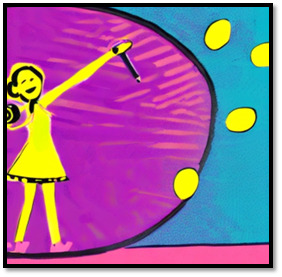
Figure 42: Happiness- Child 5
(Clicked on: 22 August 2023)
Question 2: What does happiness look like to you? Can you draw it?
For this question, Child 5 provided me with a drawing of a sun with many rays as she said that happiness is like the sun which provides warmth and brightness.

Figure 43: Happiness- Child 5
(Clicked on: 22 August 2023)
Question 3: Can you draw a picture of a place that makes you feel safe?
For this question, Child 5 provided me with a drawing of a grandmother knitting a scarf using warm colours like brown, red, and pink.
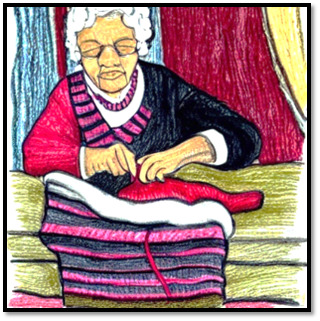
Figure 44: Safety and Comfort- Child 5
(Clicked on: 22 August 2023)
Question 4: If you could be any animal, what would you be? Show me in your drawing.
For this question, Child 5 provided me with a drawing of a dolphin with a smile as she said that she likes dolphins because they are friendly in nature and they can swim.

Figure 45: Imagination and Identity- Child 5
(Clicked on: 22 August 2023)
Question 5: Can you draw how you feel when you're angry or upset?
For this question, Child 5 provided me with a drawing of ice cream melting using cold-tone colours like white, pink, and blue.
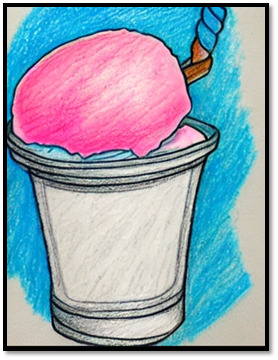
Figure 46: Angry or Upset- Child 5
(Clicked on: 22 August 2023)
Day 10: 23 August 2023
Child 5
Question 6: Can you draw a picture of something you fixed or solved?
For this question, Child 5 provided me with a drawing of a girl singing a song with notes using different colours for drawing.

Figure 47: Problem-solving or Accomplishment- Child 5
(Clicked on: 23 August 2023)
Question 7: What does friendship mean to you? Can you draw a friend?
For this question, Child 5 provided me with a drawing of a girl dancing with her friend on stage.
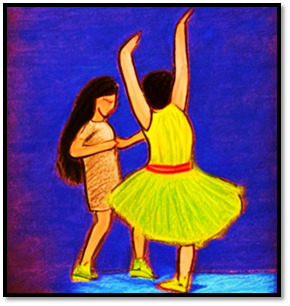
Figure 48: Friendship and Social Connection- Child 5
(Clicked on: 23 August 2023)
Question 8: Can you draw a picture of your favourite moment or something you really liked doing?
For this question, Child 5 provided me with a drawing of a girl celebrating her birthday with her friends and family using bright colours like orange, blue, and green.

Figure 49: Joy or Favorite Memory- Child 5
(Clicked on: 23 August 2023)
Question 9: Can you draw a picture of something you really want to happen in the future?
For this question, Child 5 provided me with a drawing of a girl performing on the stage using shiny colours like purple, silver, and gold.

Figure 50: Hope or Aspiration for the Future- Child 5
(Clicked on: 23 August 2023)
Question 10: Can you draw a picture of yourself doing something you don’t like?
For this question, Child 5 provided me with a drawing of a girl studying maths with confused expression on her face using dull colours like brown, white, and black for drawing.

Figure 51: Dislike or Negative Emotion- Child 5
(Clicked on: 23 August 2023)
Interpretation
The drawings of Child 5 demonstrate that she has a creative and expressive intellect as well as a pleasant heart. She expresses her pleasure, excitement, love, and despair via bright, warm, sparkly, and cool colors. Colors are also used by her to express her identity, likes, beliefs, and aspirations. She likes pink and purple, for example, since they are girly and lovely colors. She enjoys dancing and singing considering they are artistic and expressive. She enjoys suns and stars considering they are warm and bright. She enjoys dolphins considering they are friendly and can swim. She enjoys celebrating and executing considering they are joyful and exciting.
She also expresses her fear, wrath, hatred, and weariness with dull, dissolving, confused, and unpleasant colors. She also uses color to convey her feelings, thoughts, and experiences. For example, when she is sad or disappointed, she draws an ice cream cone melting considering that it represents the loss of something she enjoys; when she feels safe, she draws her grandmother considering it represents her care and affection; and when she thinks of friendship, she draws her best friend considering it represents her social connection.
Child 5's drawings are a reflection of her artistic expression as well as her identity, emotions, and social development. According to Monet "color is my day-long obsession, joy, and torment". As a teacher, I may utilize colors to get an understanding of her psychological and emotional characteristics and functions by studying how she communicates her inner states, feelings, ideas, and experiences (Uljaevna, 2022). I may also utilize colors to foster her artistry, expression, joy, and passion by giving her a variety of materials, tools, and opportunities to experiment with them.
References
Uljaevna, U. F. (2022). Development of creative activity of preschool children in art game as a psychological and pedagogical problem. Barqarorlik va yetakchi tadqiqotlar onlayn ilmiy jurnali, 47-51. http://www.sciencebox.uz/index.php/jars/article/download/3018/2752
0 notes
Text
Day 7: 20 August 2023
Child 4: Male, Age: 6 years
On 20 August 2023 for the observation, I asked Child 4, five questions from the questionnaire and asked the child to draw as the revert of the asked questions.
Question 1: Can you draw a picture of something that made you happy today?
For this question, Child 4 provided me with a drawing of himself playing lego and robots as he used bright colours as blue, yellow, and green.

Figure 32: Happiness- Child 4
(Clicked on: 20 August 2023)
Question 2: What does happiness look like to you? Can you draw it?
For this question, Child 4 provided me with a drawing of a star with many colours around it as he said happiness is like a star which shines and provides guidance.

Figure 33: Happiness- Child 4
(Clicked on: 20 August 2023)
Question 3: Can you draw a picture of a place that makes you feel safe?
For this question, Child 4 provided me with a drawing of a picture of his and his father holding hands using warm colours like yellow, orange, and red.

Figure 34: Safety and Comfort- Child 4
(Clicked on: 20 August 2023)
Question 4: If you could be any animal, what would you be? Show me in your drawing.
For this question, Child 4 provided me with a drawing of a robot as he said robots are smart and useful.

Figure 35: Imagination and Identity- Child 4
(Clicked on: 20 August 2023)
Question 5: Can you draw how you feel when you're angry or upset?
For this question, Child 4 provided me with a drawing of a cartoon monster with big eyes using dark colours like black, purple, and green.

Figure 36: Angry or Upset- Child 4
(Clicked on: 20 August 2023)
Day 8: 21 August 2023
Child 4
Question 6: Can you draw a picture of something you fixed or solved?
For this question, Child 4 provided me with a drawing of a boy making robot with lego using different colours for drawing.
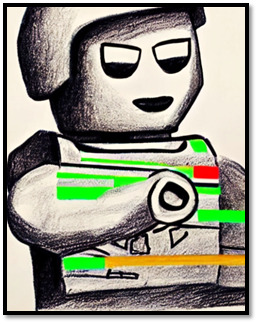
Figure 37: Problem-solving or Accomplishment- Child 4
(Clicked on: 21 August 2023)
Question 7: What does friendship mean to you? Can you draw a friend?
For this question, Child 4 provided me with a drawing of a boy helping his friend to do his homework wearing the same clothes.

Figure 38: Friendship and Social Connection- Child 4
(Clicked on: 21 August 2023)
Question 8: Can you draw a picture of your favourite moment or something you really liked doing?
For this question, Child 4 provided me with a drawing of a boy winning a gaming competition using bright colours like white, gold, and yellow.
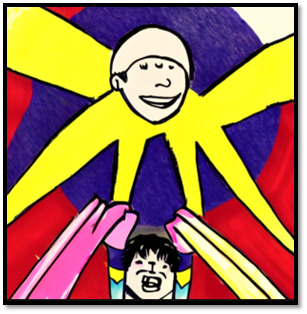
Figure 39: Joy or Favorite Memory- Child 4
(Clicked on: 21 August 2023)
Question 9: Can you draw a picture of something you really want to happen in the future?
For this question, Child 4 provided me with a drawing of a boy engineer working on a big project using colours like silver, grey, and blue.

Figure 40: Hope or Aspiration for the Future- Child 4
(Clicked on: 21 August 2023)
Question 10: Can you draw a picture of yourself doing something you don’t like?
For this question, Child 4 provided me with a drawing of a boy doing house chors with an unhappy face using dull colours like black and brown.

Figure 41: Dislike or Negative Emotion- Child 4
(Clicked on: 21 August 2023)
Interpretation
Child 4's drawings demonstrate a rational and analytical intellect as well as a competitive drive. He expresses his delight, enthusiasm, confidence, and anxiety through the employment of bright, warm, chilly, and dark colors. Colors are also used by him to express his personality, likes, values, and aspirations. He likes blue and green, for example, since they are calm and fresh colors. He like Lego and robots considering they are complicated and entertaining. He enjoys stars considering they are brilliant and motivating. He enjoys building and winning considering they are tough and rewarding. He enjoys engineering considering that it is a creative and helpful job.
He also expresses his melancholy, wrath, disdain, and boredom through the use of drab monsterous unpleasant and dark colors. He also use color to convey his feelings, thoughts, and experiences. For example, when he is terrified or apprehensive, he draws a monster with enormous eyes and teeth to depict the threat in his head; when he is safe, he draws his father to represent his protection and direction. When he thinks about friendship, he sketches his best buddy since it reflects his social relationship.
Child 4's drawings are a reflection of his artistic expression as well as his identity, emotions, and social development. "Color is a power that directly influences the soul," remarked Kandinsky (Suk, 2006). As a teacher, I may utilize colors to get an understanding of his psychological and emotional characteristics and functions by seeing how he uses them to convey his inner states, feelings, ideas, and experiences (Miles, 2004). I can also utilize colors to boost his logic understanding competition and conviction by giving him a variety of materials, tools, and opportunities to experiment with them.
References
Miles, M. (Ed.). (2004). New practices-new pedagogies: a reader. Routledge.
Suk, H. J. (2006). Color and Emotion-a study on the affective judgment across media and in relation to visual stimuli. None.
0 notes
Text
Day 5: 18 August 2023
Child 3: Female, Age: 5 years
On 18 August 2023 for the observation, I asked Child 3, five questions from the questionnaire and asked the child to draw as the revert of the asked questions.
Question 1: Can you draw a picture of something that made you happy today?
For this question, Child 3 provided me with a drawing of herself reading a book under the tree as she used soft colours like green, blue, and pink.

Figure 22: Happiness- Child 3 (Clicked on: 18 August 2023)
Question 2: What does happiness look like to you? Can you draw it?
For this question, Child 3 provided me with a drawing of a flower with many petals as she said happiness is like a flower that blooms and grows.

Figure 23: Happiness- Child 3
(Clicked on: 18 August 2023)
Question 3: Can you draw a picture of a place that makes you feel safe?
For this question, Child 3 provided me with a drawing of her and her mother hugging each other as she used warm colours like pink, yellow, and red.
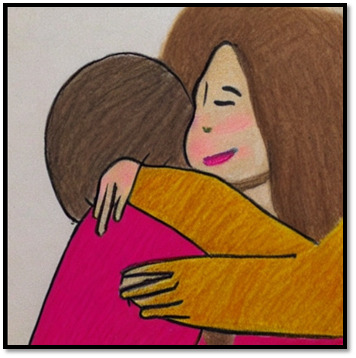
Figure 24: Safety and Comfort- Child 3
(Clicked on: 18 August 2023)
Question 4: If you could be any animal, what would you be? Show me in your drawing.
For this question, Child 3 provided me with a drawing of a bird with colourful feathers as she said she likes birds because they are free and they can also sing.

Figure 25: Imagination and Identity- Child 3
(Clicked on: 18 August 2023)
Question 5: Can you draw how you feel when you're angry or upset?
For this question, Child 3 provided me with a drawing of an broken heart with tears as she used cool colours like blue, gray, and purple.
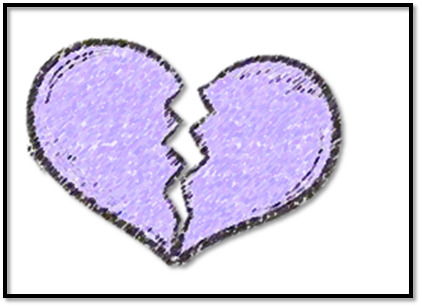
Figure 26: Angry or Upset- Child 3
(Clicked on: 18 August 2023)
Day 6: 19 August 2023
Child 3
Question 6: Can you draw a picture of something you fixed or solved?
For this question, Child 3 provided me with a drawing of a drawing of a girl writing in copy with a pencil using different colours.

Figure 27: Problem-solving or Accomplishment- Child 3
(Clicked on: 19 August 2023)
Question 7: What does friendship mean to you? Can you draw a friend?
For this question, Child 3 provided me with a drawing of a girl sharing food with her friend wearing the same colour clothes for both girl and her friend.

Figure 28: Friendship and Social Connection- Child 3
(Clicked on: 19 August 2023)
Question 8: Can you draw a picture of your favourite moment or something you really liked doing?
For this question, Child 3 provided me with a drawing of a rainbow on the wall using bright colours like red, purple, pink, green, blue, indigo, and violet.

Figure 29: Joy or Favorite Memory- Child 3
(Clicked on: 19 August 2023)
Question 9: Can you draw a picture of something you really want to happen in the future?
For this question, Child 3 provided me with a drawing of a girl sitting in front of the teacher in class using soft colours like brown and white.

Figure 30: Hope or Aspiration for the Future- Child 3
(Clicked on: 19 August 2023)
Question 10: Can you draw a picture of yourself doing something you don’t like?
For this question, Child 3 provided me with a drawing of a girl cleaning her room with a bored face using dull colours like grey, black, and white.

Figure 31: Dislike or Negative Emotion- Child 3
(Clicked on: 19 August 2023)
Interpretation
The drawings of Child 3 demonstrate that she has an imaginative and expressive intellect as well as a compassionate heart. She expresses her pleasure, love, joy, and despair via the use of soft, warm, brilliant, and cold colors. Colors are also used by her to express her identity, likes, beliefs, and aspirations. She likes green and blue, for example, since these are tranquil and pleasant colors. She enjoys stories and books because they are intriguing and imaginative; flowers and birds considering they are charming and natural; painting and writing considering they are imaginative and expressive; rainbows considering they are colorful and magical; and teaching because she believes it is an honorable and rewarding profession.
She also expresses her fear, wrath, hatred, and boredom through the choice of dull, broken, teary, and bored colors. She also use color to convey her feelings, thoughts, and experiences. For example, when she is sad or upset, she draws a heart that is broken to reflect the anguish in her heart; when she feels secure, she draws her mother to represent her love and support; and when she thinks about friendship, she draws her best friend to indicate her social connection.
Child 3's drawings are a reflection of her artistic expression as well as her identity, emotions, and social development. "If you hear a voice within you say you cannot paint,' then paint, and that voice will be silenced" stated Van Gogh (Team, 2023). As a teacher, I may utilize colors to get an understanding of her psychological and emotional characteristics and functions by studying how she communicates her inner nations, feelings, ideas, and experiences (McNally, 2013). I may also utilize colors to foster her creativity, expressiveness, uniqueness, and tenderness by giving her a variety of materials, tools, and opportunities to experiment with them.
References
McNally, A. (2013). All that stuff! Organising records of creative processes. Judy Vaknin [et al.](Hg.): All this Stuff–Archiving the Artist, Faringdon (Oxfordshire), 97-108.
Team, C. (2023). Van Gogh: The Solitude of a Starry Night. ChatStick Team. https://www.google.co.in/books/edition/Van_Gogh_The_Solitude_of_a_Starry_Night/s0zPEAAAQBAJ?hl=en&gbpv=0
0 notes
Text
Day 3: 16 August 2023
Child 2: Male, Age: 4 Years
On 16 August 2023 for the observation, I asked Child 2, five questions from the questionnaire and asked the child to draw as the revert of the asked questions.
Question 1: Can you draw a picture of something that made you happy today?
For this asked question Child 2 provided me with a drawing of a truck driving himself on the road as he used bright colours like yellow, red, and green.
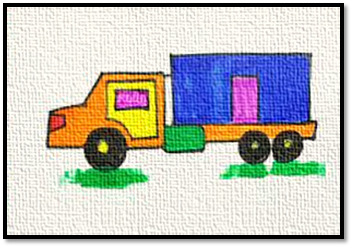
Figure 12: Happiness- Child 2
(Clicked on: 16 August 2023)
Question 2: What does happiness look like to you? Can you draw it?
For this question, Child 2 provided me with a drawing of a smiley face with different colours around it as he said that happiness is like having many friends who make him smile.

Figure 13: Happiness- Child 2 (Clicked on: 16 August 2023)
Question 3: Can you draw a picture of a place that makes you feel safe?
For this question, Child 2 provided me with a drawing of a classroom with a teacher and other classmates as he used warm colours like brown and orange.
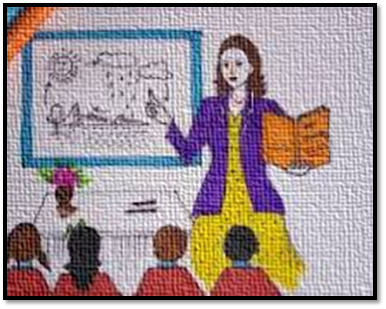
Figure 14: Safety and Comfort- Child 2 (Clicked on: 16 August 2023)
Question 4: If you could be any animal, what would you be? Show me in your drawing.
For this question, Child 2 provided me with a drawing of a lion with big teeth and claws as he said he likes lions because they are strong and brave in nature.

Figure 15: Imagination and Identity- Child 2 (Clicked on: 16 August 2023)
Question 5: Can you draw how you feel when you're angry or upset?
For this question, Child 2 provided me with a drawing of an angry face with fire coming out from its mouth using dark colours like red, orange, and black.
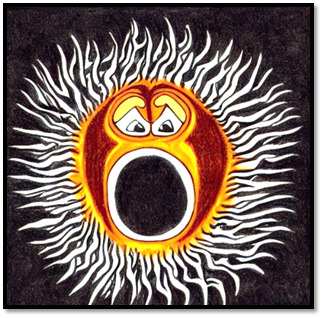
Figure 16: Angry or Upset- Child 2 (Clicked on: 16 August 2023)
Day 4: 17 August 2023
Child 2 Question 6: Can you draw a picture of something you fixed or solved?
For this question, Child 2 provided me with a drawing of a boy building a tower with blocks using different colours.

Figure 17: Problem-solving or Accomplishment- Child 2 (Clicked on: 17 August 2023)
Question 7: What does friendship mean to you? Can you draw a friend?
For this question, Child 2 provided me with a drawing of a boy playing football with his friend in garden using the same colour for their cloths.

Figure 18: Friendship and Social Connection- Child 2 (Clicked on: 17 August 2023)
Question 8: Can you draw a picture of your favourite moment or something you really liked doing?
For this question, Child 2 provided me with a drawing of a boy flying an airplane in the sky using bring colours like white, yellow, and blue.

Figure 19: Joy or Favorite Memory- Child 2 (Clicked on: 17 August 2023)
Question 9: Can you draw a picture of something you really want to happen in the future?
For this question, Child 2 provided me with a drawing of a boy in an astronaut dress in space using dark colours like purple, black, and silver.
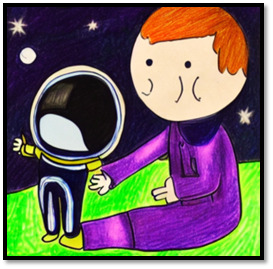
Figure 20: Hope or Aspiration for the Future- Child 2 (Clicked on: 17 August 2023)
Question 10: Can you draw a picture of yourself doing something you don’t like?
For this question, Child 2 provided me with a drawing of a boy eating broccoli with disgusted face using dull colours like brown, green, and gray.
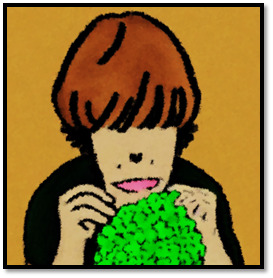
Figure 21: Dislike or Negative Emotion- Child 2 (Clicked on: 17 August 2023)
Interpretation
Child 2's drawings reveal a curious and exploratory attitude as well as a competitive mentality. He expresses his delight, enthusiasm, courage, and fury via bright, warm, and dark colors. Colors are also used by him to express his personality, likes, values, and aspirations. He enjoys red and yellow considering they are bright and energetic colors, trucks and cars because they are fast and powerful, lions because they are strong and brave, building blocks given that they are challenging and fun, flying and the space because they are thrilling and mysterious, and football because it is a sport which demands skill and teamwork.
He also expresses his despair, fear, and hatred through the choice of drab, fiery, and disgusting colors. He also use color to express his feelings, thoughts, and experiences. For example, when he is angry or upset, he draws an angry face with fire to represent the intensity of his emotion; when he feels safe, he draws his classroom to represent his learning environment; and when he thinks of friendship, he draws his best friend to represent his social connection.
Child 2's drawings are a reflection of his artistic expression as well as his identity, emotions, and social development. "Creativity requires courage," stated Matisse (Issuu, 2023). As a teacher, I may utilize colors to get an understanding of his psychological and emotional characteristics and functions by monitoring how he communicates his inner nations, feelings, ideas, and experiences (Lomax, 1981). I may also utilize colors to foster his creativity, curiosity, excitement, and courage by giving him with a variety of materials, equipment, and opportunity to experiment with them.
References
Issuu. (2023). “Creativity Takes Courage” - Henri Matisse. Available at: https://issuu.com/thebsbblog/docs/art_catalogue_23/s/25044502 (Accessed 26 August 2023).
Lomax, Y. (1981). Writing the image: an adventure with art and theory.
0 notes
Text
Observational Record
Questionnaire Observational Recording
Day 1: 14 August 2023
Child 1: Female, Age: 3 years
During the first day of the observation, I asked Child 1, five questions from the questionnaire and asked the child to draw as the revert of the asked questions.
Question 1: Can you draw a picture of something that made you happy today?
For this asked question Child 1 provided me with a drawing of herself sitting holding a doll and smiling.

Figure 2: Happiness- Child 1
(Clicked on: 14 August 2023)
Question 2: What does happiness look like to you? Can you draw it?
For this asked question Child 1 provided me with a drawing of a heart with many colours inside, as she said that happiness to her is like a rainbow.

Figure 3: Happiness- Child 1 (Clicked on: 14 August 2023)
Question 3: Can you draw a picture of a place that makes you feel safe?
For this asked question Child 1 provided me with a drawing of her house with her family while using warm colours like red, orange, and brown.

Figure 4: Safety and Comfort- Child 1 (Clicked on: 14 August 2023)
Question 4: If you could be any animal, what would you be? Show me in your drawing.
For this asked question Child 1 provided me with a drawing of a butterfly with colourful wings as she said that she likes butterflies because they are beautiful and they can fly.

Figure 5: Imagination and Identity- Child 1 (Clicked on: 14 August 2023)
Question 5: Can you draw how you feel when you're angry or upset?
For this asked question Child 1 provided me with a drawing of a stormy sky with dark clouds and lightning using dark colours like black, blue, and gray.

Figure 6: Angry or Upset- Child 1 (Clicked on: 14 August 2023)
Day 2: 15 August 2023
Child 1
Question 6: Can you draw a picture of something you fixed or solved?
For this question, Child 1 provided me with a drawing of a puzzle of a cartoon with all pieces in place using different colours for every piece.

Figure 7: Problem-solving or Accomplishment- Child 1 (Clicked on: 15 August 2023)
Question 7: What does friendship mean to you? Can you draw a friend?
For this question, Child 1 provided me with a drawing of a girl and her friend walking on the road using the same colours for both of their clothes.

Figure 8: Friendship and Social Connection- Child 1
(Clicked on: 15 August 2023)
Question 8: Can you draw a picture of your favourite moment or something you really liked doing?
For this question, Child 1 provided me with a drawing of a girl riding a unicorn in a fairyland using glittery colours like goal, silver, and pink.

Figure 9: Joy or Favorite Memory- Child 1
(Clicked on: 15 August 2023)
Question 9: Can you draw a picture of something you really want to happen in the future?
For this question, Child 1 provided me with a drawing of a girl wearing a princess gown with a crown using shiny colours like green, yellow, and purple.

Figure 10: Hope or Aspiration for the Future- Child 1
(Clicked on: 15 August 2023)
Question 10: Can you draw a picture of yourself doing something you don’t like?
For this question, Child 1 provided me with a drawing of a girl sitting in a corner with a sad face using dull colours like brown, grey, and white.

Figure 11: Dislike or Negative Emotion- Child 1
(Clicked on: 15 August 2023)
Interpretation
The drawings of Child 1 demonstrate that she has a creative imagination and a good attitude on life. She expresses her enthusiasm, excitement, love, and aspirations via bright, warm, sparkling, and shiny colors. Colors are also used by her to express her identity, likes, beliefs, and aspirations. For example, she enjoys the colors pink and purple because she finds them girly, butterflies considering they are beautiful and can fly, puzzles considering they are challenging and fun, unicorns because they ought to are magical and rare, and princesses for the reason they are elegant and powerful.
She also expresses her wrath, grief, fear, and hatred through dark, chilly, dreary, and stormy colors. She also use color to express her feelings, thoughts, and experiences. For example, when she is angry or sad, she draws a stormy sky to reflect the turmoil in her head; when she feels comfortable, she draws her house to represent her comfort zone; and when she thinks about friendship, she draws her closest friend to indicate her social connection.
Child 1's drawings are a reflection of her artistic expression as well as her identity, emotions, and social development. "Every child is an artist, the issue is how to stay an artist as we get older" stated Picasso. As a teacher, I may utilize colors to get an understanding of her psychological and emotional characteristics and functions by studying how she communicates her inner nations, feelings, ideas, and experiences (Barrett and Bolt, 2014). I may also utilize colors to foster her creativity, imagination, originality, and expression by offering her a variety of materials, tools, and opportunities to experiment with them.
Reference
Barrett, E., and Bolt, B. (Eds.). (2014). Practice as research: Approaches to creative arts enquiry. Bloomsbury Publishing.
0 notes
Text
Experiments Conducted
The 5 research subjects, that is children were provided with a questionnaire consisting of 10 questions, where each question considering one or two emotions of children. Furthermore, the observation was conducted for two weeks from 14 August 2023 to 27 August 2023. The recording of the observation was initiated for 10 days with 5 children, for the remaining 2 days, children were provided with creative and non-creative tasks for one day each. Whereas, the last 2 days were used by me to simplify the observations and record them accordingly while creating the collage of products produced by children.
**Note: Each Child was observed for 2 days**
0 notes
Text
Methodology and Data Collection
Materials Used
Questionnaire
I created a questionnaire with ten types of emotions with questions on interests, objectives, preferences, values, feelings, and problems. I conducted one-on-one interviews with each child and documented their responses using the specified questionnaire. I was able to gain a basic understanding of children's personalities, behaviors, difficulties, emotions, mental processes, and sentiments thanks to this questionnaire.
"Artistic Expression as a Reflection of Children's Identity, Emotion, and Social Development" was the major focus of my research. I was interested in seeing how my knowledge of teaching may help me better understand the emotional and psychological characteristics and processes of primary school-aged children. Therefore, I utilized the questionnaire to gather information from the kids, and I then compared their answers to the artistic expressions of children.
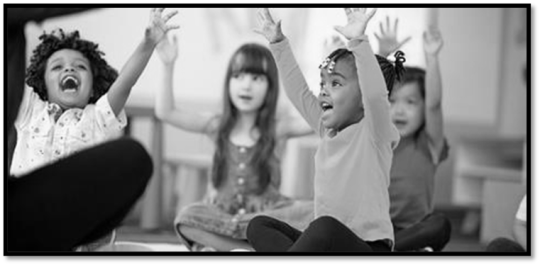
Figure 1: Children are happy while playing Games
Source: (Healthy Child, 2023)
Accessed on: (17 August 2023)
Furthermore, Suk (2006) also stated that “Color is a power which directly influences the soul.” Therefore, with this questionnaire, I wanted to discover how important colors are in children's social, emotional, and identity development. In addition to their usage for aesthetic purposes, colors may be utilized to express a person's innermost feelings, ideas, and experiences. The children's personality qualities, tastes, values, and aspirations will also be reflected in their choice of colors. For example, Child 1, might select dark and chilly hues to portray his melancholy, loneliness, and concern, whereas, Child 2 might favor bright and warm hues to show her pleasure, optimism, and excitement. It is also possible that Child 3, might use color to comply with societal norms and expectations, but Child 4 will use color to express her originality and distinctiveness.
Questionnaire Used for Observation Recording
Q1: Can you draw a picture of something that made you happy today?
Q2: What does happiness look like to you? Can you draw it?
Q 3: Can you draw a picture of a place that makes you feel safe?
Q4: If you could be any animal, what would you be? Show me in your drawing.
Q5: Can you draw how you feel when you're angry or upset?
Q6: Can you draw a picture of something you fixed or solved?
Q7: What does friendship mean to you? Can you draw a friend?
Q8: Can you draw a picture of your most favourite moment or something you really liked doing?
Q9: Can you draw a picture of something you really want to happen in the future?
Q10: Can you draw a picture of yourself doing something you don’t like?
Covered emotions among the questions:
Q1: Happiness
Q2: Happiness
Q3: Safety and Comfort
Q4: Imagination and Identity
Q5: Anger or Upset
Q6: Problem-solving or Accomplishment
Q7: Friendship and Social Connection
Q8: Joy or Favorite Memory
Q9: Hope or Aspiration for the Future
Q10: Dislike or Negative Emotion
Drawing Task
In addition to the quarionnaire, I combined it with some drawing tasks where I gave the children a drawing assignment in order to investigate how kids communicate their feelings and mental processes through art. Children were instructed to a drawing whatever initially came to their minds after being given a single word, such as "happy" or "sad." I then made note of the drawing's style, color scheme, and mood. I was able to comprehend how they expressed their feelings and cognitive processes through art thanks to the drawing assignment. I was curious to observe how children used color to express their emotions, ideas, and identities through drawing. As it has been argued by Suk (2006) that “Color is a power which directly influences the soul”. Therefore, I aimed to extract children's actual sentiments and thoughts which might not be easily articulated orally by asking them to express themselves through their impulsive responses to emotive phrases. Moreover, a different approach therapeutic activity that might assist kids in overcoming stress and trauma is drawing as Van Gogh described “I have lost my mind in the process of pouring my heart and soul into my work” (Team, 2023).
Experiment: Situation Creation
I carried out a situation creation work with the kids in order to investigate how they act and think in various situations. I saw kids from a distance in two distinct scenarios. Situation 1: Children were given personal creative assignments like learning to make origami or paint. Situation 2: A non-creative job, such as calculating arithmetic equations or writing an essay, was assigned to the students. I did not obstruct, hinder, or otherwise affect their actions as an observer. I merely watched them and noted each circumstance's motive, behavior, delight, frustration, and level of inventiveness. I was able to examine and contrast the various scenarios' effects on children's behavior and thought processes.
The scenario-creation task was related to my research question, "How could colors help me as a teaching expert to gain insight into the emotional and psychological aspects and functions of children from elementary school age-group?" and my research topic, "Artistic Expression as a Reflection of Children's Identity, Emotion and Social Development." I was curious to discover how youngsters used color to express their emotions, ideas, and identities through imaginative activities. The quote from Matisse "Creativity takes courage" comes to mind (Issuu, 2023). I aimed to inspire kids to express their individuality and creativity through color by giving them personal creative assignments like making origami or painting. In contrast to non-creative activities like completing arithmetic equations or writing an essay, I also wanted to observe how colors affected people's motivation, behaviors, enjoyment, aggravation, and inventiveness.“Logic will get you from A to B, but your imagination could get you anywhere” as remarked by Albert Einstein (Stokes, 2014).
Painting and Collage
Moreover, based on my whole observation of 2 weeks, I will develop it into drawings and paintings that will capture the essence of each child’s personality, thought process, and feelings. Therefore, based on the colours used by children, I will analyze them to convey the interpretation of my observation of their psychologies and emotional states (Carrington and Suzanne, 2007). I will then develop a collage out of my gathered and designed paintings which will represent the diversity and complexity of the inner world of children.
References
Carrington, Suzanne B. (2007) Young people as researchers using image-based research: a focus on methodology. In Proceedings AERA National Meeting, Chicago, USA.
Issuu. (2023). “Creativity Takes Courage” - Henri Matisse. Available at: https://issuu.com/thebsbblog/docs/art_catalogue_23/s/25044502 (Accessed 26 August 2023).
Stokes, D. (2014). The role of imagination in creativity. The philosophy of creativity: New essays, 157-184. https://philpapers.org/archive/STOTRO-17
Suk, H. J. (2006). Color and Emotion-a study on the affective judgment across media and in relation to visual stimuli. None.
Team, C. (2023). Van Gogh: The Solitude of a Starry Night. ChatStick Team. https://www.google.co.in/books/edition/Van_Gogh_The_Solitude_of_a_Starry_Night/s0zPEAAAQBAJ?hl=en&gbpv=0
Healthy Children, (2023). Social Development in Preschoolers. Available at:https://www.healthychildren.org/English/ages-stages/preschool/Pages/Social-Development-in-Preschoolers.aspx (Accessed 28 August 2023).
0 notes
Text
Artistic Expression as a Reflection of Children's Identity, Emotion and Social Development
Introduction
Art is in a league of its own when it comes to conveying the breadth and depth of the human experience. The bright strokes of a paintbrush, the rhythmic movements of dance, or the exquisite melodies of music may be used to portray expressions of emotion, thought, and creativity that are difficult to put into words (Kourkoulis, 2021). Children have a great deal of potential to learn about themselves and express themselves via the medium of art, which has a lot of promise. The personalities, feelings, and social development of young people may be better understood by looking at their creative works, which gives a multifaceted window into their minds. Young children often have a restricted linguistic development, which may sometimes hinder them from appropriately expressing their thoughts and emotions. In this context, art functions as the connecting element between the abstract and the concrete. When a kid makes a work of art, whether it's a joyful explosion of colour on canvas or a sculpture that's been shaped with determination, that piece of art becomes a window into the child's mind. The vivid colours they use, the subjects they paint, and the forms they carve may all provide insight into the artists' states of mind, preferences, and imaginative capacities (Carrington, 2007). When children have an outlet where they may safely explore and express their feelings, such as via artistic hobbies, this helps them develop the emotional intelligence and resilience necessary for healthy adulthood.
In addition, there is a function for art that extends beyond the sphere of private expression. It's a fantastic activity for fostering empathy and helping children experience what others are going through. They gain the ability to sympathise with others by placing themselves in the position of the protagonists in stories, plays, and other forms of artistic expression (Rezaee et al., 2022). Empathy may be learned by putting oneself in the shoes of another person and experiencing what it is like to deal with the challenges they face. This not only promotes one's own personal growth but also leads to an improvement in social awareness, which in turn leads to better interactions with one's peers. In spite of the undeniable significance that art plays in the development of children, there is still a dearth of research on the ways in which it might shed light on children's personality traits, behaviours, and emotions (Sanders, 2009). According to Ravenscroft (2009), “colors are more than just a visual phenomenon; they are also meaning transmitters, which may elicit emotions and relationships between people”.
Thus, one of the powerful tools to express emotions, thoughts, feelings, and creativity is art. It could also be used in the form of a tool through which individuals will be able to understand the emotions of others and enhance the learning and development of the children. Other than this, there is a lack of research on the subject, of “how art can be useful for observing and assessing personality, behaviour, thought process, and feelings of children in different contexts and scenarios”. Thus, the major aim of this project is to explore the topic “How colours could assist me as a teaching expert to gain insight into the emotional and psychological aspects and functions of children from elementary school age-group.
References
Carrington, Suzanne B. (2007) Young people as researchers using image-based research: a focus on methodology. In Proceedings AERA National Meeting, Chicago, USA.
Kourkoulis, L. (2021). The Network of Influences That Shape the Drawing and Thinking of Fifth Grade Children in Three Different Cultures: New York, US, Molaos, Greece, and Wadie Adwumakase, Ghana. Teachers College, Columbia University. https://academiccommons.columbia.edu/doi/10.7916/d8-753v-t132/download
Ravenscroft, I. ed., 2009. Chapter 6: The Folk Theory of Colours and the Causes of Colour Experience. Minds, ethics, and conditionals: themes from the philosophy of Frank Jackson. Oxford University Press.
Rezaee, F., Hoseinikhah, A., Kian, M., & Kamran, A. (2022). A Comparative Study of Art Curriculum in Early Childhood Education of Australia, Canada, Finland, New Zealand and Iran. Iranian Journal of Comparative Education, 5(4), 2098-2125. https://journal.cesir.ir/article_160839.html
Sanders, A. M. C. (2009). Identity hokey pokey:" put your whole self in" with theatre as your guide (Doctoral dissertation, California State University, Sacramento). https://scholars.csus.edu/esploro/fulltext/graduate/IDENTITY-HOKEY-POKEY-PUT-YOUR-WHOLE/99257972358301671?repId=12255750810001671&mId=13255750780001671&institution=01CALS_USL
1 note
·
View note